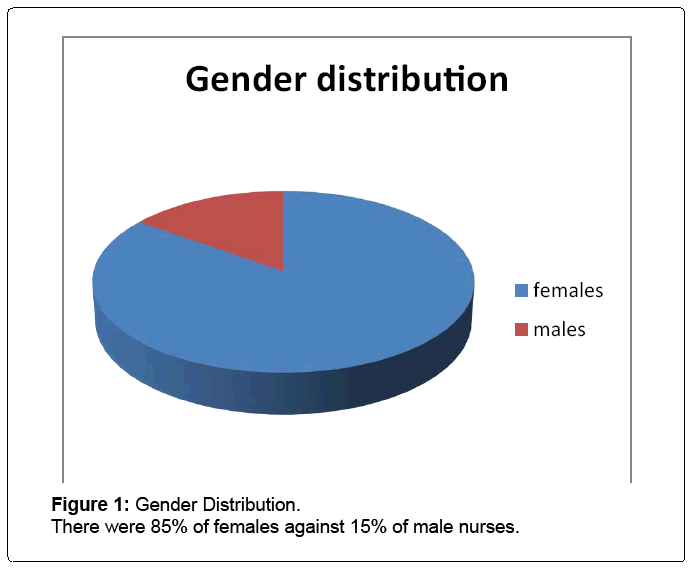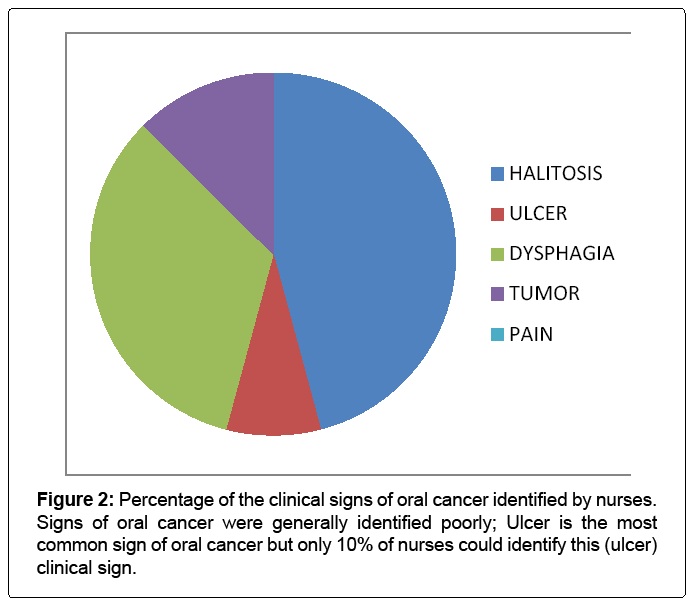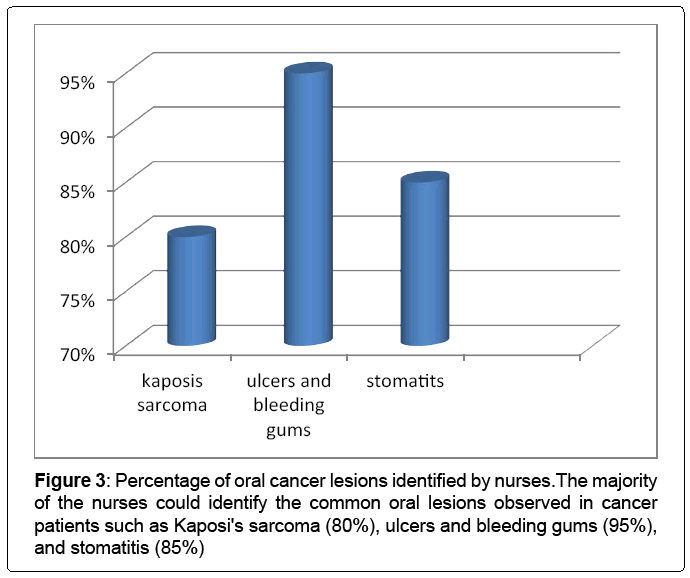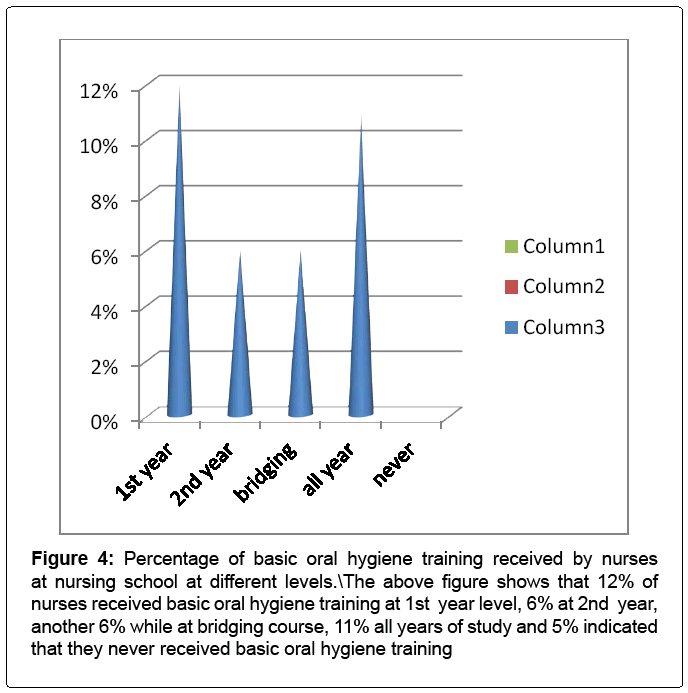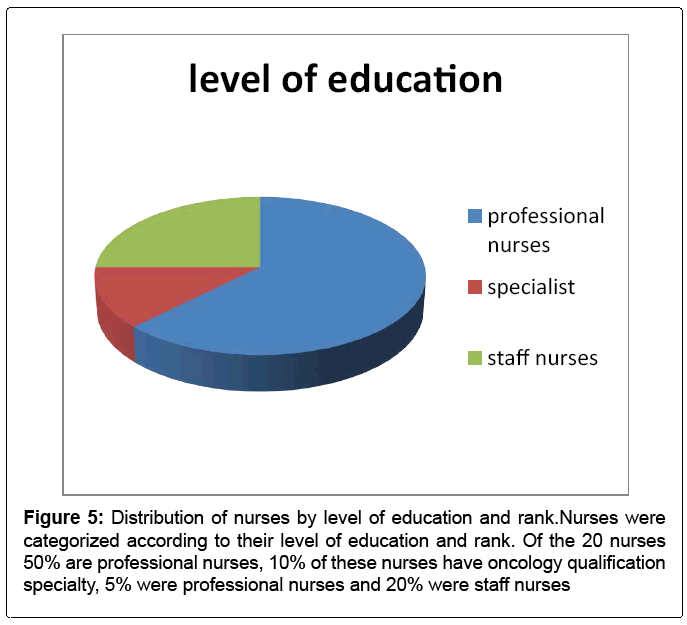Research Article Open Access
Oral Health Awareness of Onclogy Nurses at Charllotte Maxeke Johannesburg Hospital
Tsholofelo Mokale* and Maphefo D ThekisoFaculty of Health Sciences, University of Witwatersrand, Johannesburg, South Africa
- *Corresponding Author:
- Tsholofelo Mokale
University of Witwatersr and Department
of Community Dentistry, School of Oral Health
Sciences, Faculty of Health Sciences
7 York Road, Park town 2193, South Africa
Tel: (011) 717-2175
Fax: (011) 717-2625
E-mail: tsholofelo.mokale@wits.ac.za
Received Date: November 27, 2015; Accepted Date: February 16, 2016; Published Date: February 22, 2016
Citation: Mokale T, Thekiso MD (2016) Oral Health Awareness of Onclogy Nurses at Charllotte Maxeke Johannesburg Hospital. J Oral Hyg Health 4:199. doi:10.4172/2332-0702.1000199
Copyright: © 2016 Mokale T, et al. This is an open-access article distributed under the terms of the Creative Commons Attribution License, which permits unrestricted use, distribution, and reproduction in any medium, provided the original author and source are credited.
Visit for more related articles at Journal of Oral Hygiene & Health
Abstract
Aim: The aim of the study was to investigate whether nurses working at oncology department staff are aware of the risk factors and clinical signs of oral cancer. The objectives were firstly to determine the level of awareness on the risk factors and the clinical signs of oral cancer amongst oncology nurses secondly to determine whether basic oral hygiene was taught in their curriculum.
Methods: The study was conducted among twenty full time nursing staff working in the oncology wards at the Charlotte Maxeke Academic Hospital. A self-administered questionnaire was used to assess the nurse’s level of awareness and knowledge on the risk factors, clinical signs and training on basic oral hygiene.
Results: Over 85% of the nurses thought that an oral health screening is very important although only 5% performed this task regularly and gave advice to their patients about the risk of oral cancer. Majority of the nurses could identify the common oral lesions observed in cancer patients such as Kaposi’s sarcoma (80%), ulcers and bleeding gums (95%), and stomatitis (85%) as indicated on. Nurses were categorized according to their level of education and rank 50% were professional nurses, 10% had oncology specialty qualification, 5% were professional nurses and 20% were staff nurses.
Conclusion: It is important for nurses to be able to diagnose oral cancer especially those based at the oncology department. Nurses awareness of oral cancer risk factors and clinical signs was poor. Thus there is a need to train nurses on oral cancer to make it viable for oral cancer screening of patients upon admission.
Keywords
Oral health; Oncology nurses; Oral hygeine
Introduction
Oral cancer is a serious and growing problem in many parts of the globe. Oral and pharyngeal cancer, grouped together, is the sixth most common cancer in the world. The annual estimated incidence1 is around 275,000 for oral and 130,300 for pharyngeal cancers excluding nasopharynx, two-thirds of these cases occurring in developing countries. The areas characterised by high incidence rates for oral cancer excluding lip are found in the South and Southeast Asia e.g. Sri Lanka, India, Pakistan and Taiwan, parts of Western e.g. France and Eastern Europe (e.g. Hungary, Slovakia and Slovenia, parts of Latin America and the Caribbean e.g. Brazil, Uruguay and Puerto Rico and in Pacific regions e.g. Papua New Guinea and Melanesia [1].
The International Agency for Research of Cancer [2] estimates that there are 12.7 million new cancer cases worldwide [2]. Cancer is an emerging public health problem in South Africa (SA) [1]. The latest data from National Cancer Registry of SA males have an overall age standardised incidence rate of 135.89 per 100,000 and lifetime risk of developing cancer of 1 in 7, whereas females have an age standardised incidence rate of 115.53 per 100.000 and a lifestyle risk of developing cancer of 1 in 8. Thus in SA cancer is becoming a growing health problem for both males and females [2].
Oral cancer forms in the tissues of the oral cavity or the oropharynx [3]. It can occur in any part of the mouth such as floor of the mouth and lateral border of the tongue [4].
It is vital for cancer to be detected early as deaths from oral cancer could be reduced. Changes in the mouth may signal the beginnings of cancer that can be seen or felt easily. There are two lesions that could be precursor of cancer which are leukoplakia known as white lesions and erythroplakia known as red lesions. A biopsy can be taken if this lasts for more than two weeks to obtain a definite diagnosis [5].
Oral cancer is largely preventable [6] and early diagnosis of the malignancy greatly increases survival rates as the mouth is easily accessible for self or clinical examination. The prognosis of oral cancer is poor with lowest survival rates of less than 50%, within a five year period [7]. Despite advances in the diagnosis and treatment of oral cancer, the proportion of oral cancer cases diagnosed at an early and localized stage is still below 50% [8].
Background
Oral cancer is a major public health problem that affects many people of different races and cultures. Therefore, it is important that opportunistic oral health screenings by nurses should be performed on daily basis so that oral cancer is detected in its early stages as cancer can be silent in symptomology. Also nurses must educate their patient on the risk factors of oral cancer and self-examination to prevent the spread of the disease. Thus this study focused identification of oral cancer lesions by oncology nurses. This study questioned nurses working at the oncology clinic at Charlotte Maxeke Academic Hospital in Johannesburg (South Africa) on their awareness of oral cancer, its clinical signs and their training education and evaluate their knowledge based. The results were analysed using Epi-Info. Participants were ward based nurses who were approached by the researcher and asked to complete a questionnaire on the absence of the researcher. Aim was to investigate whether nurses working at oncology department staff are aware of risk factors for oral cancer and its clinical signs.
Objectives
To determine the level of awareness of oncology nurses on the risk factors, clinical signs of oral cancer, to determine whether basic oral hygiene was taught in their curriculum. Prevention of oral complications and providing thorough oral care can prevent life-threatening infections and provide greater comfort for patients Holmes [8]. In the light of this, patients who are undergoing chemotherapy and/or radiotherapy require nurses with adequate knowledge and education in oral care and oral health assessment to care for them. However, education and knowledge in relation to oral care among nurses working in oncology settings has received little research [9]. According to Ohrn et al. [10] very little is known on how nurses manage oral care for patients with cancer. As a result there is a need for a study to describe nurses’ knowledge and education of oral care and oral health assessment for patients receiving cancer treatment in the oncology setting.
Methodology
A cross-sectional was conducted amongst twenty full time nursing staff at the oncology wards of Charlotte Maxeke Academic Hospital. A self-administered questionnaire was designed assessing the nurse’s level of awareness and knowledge on the risk factors, clinical signs and training on basic oral hygiene. A waiver to do the study was issued by the Health Research Ethics Committee (HREC) of the University of the Witwatersrand, Johannesburg (M130944).
Result
Majority of nurses were females (85%) (Figure 1) with 50% being professional nurse and 10% of this subgroup were having post graduate qualification in oncology. Awareness of the clinical signs of oral cancer was low and they were able to identify the following signs: 7% pain, 10% ulcers, 15% tumours, 10% mucositis, 40% dysphagia and 55% halitosis as illustrated in Figure 2. Over 85% of the nurses thought that an oral health screening is very important although only 5% performed this task regularly and gave advice to their patients about the risk of oral cancer. Majority of the nurses could identify the common oral lesions observed in cancer patients such as Kaposi’s sarcoma (80%), ulcers and bleeding gums (95%), and stomatitis (85%) as indicated in Figure 3. Approximately 26% of the participants were 6-10 years’ experience in oncology. In relation to receiving basic oral hygiene training at nursing school only 12% of nurses reported to have received basic oral hygiene training at 1st year level, 6% at 2nd year and while at bridging course, 11% all years of study and 5% indicated that they never received training (Figure 4). Nurses were categorized according to their level of education and rank. Of the 20 nurses 50% are professional nurses, 10% of these nurses have oncology qualification specialty, 5% were professional nurses and 20% were staff nurses (Figure 5).
Figure 4: Percentage of basic oral hygiene training received by nurses at nursing school at different levels.\The above figure shows that 12% of nurses received basic oral hygiene training at 1st year level, 6% at 2nd year, another 6% while at bridging course, 11% all years of study and 5% indicated that they never received basic oral hygiene training
Discussion
This study investigated the awareness and knowledge of oncology nurses regarding the clinical signs of oral cancer, cancer lesions and basic oral health. The study showed that nurses were unable to identify the clinical signs of oral cancer as the percentages shows in Figure 2 most of the nurses could identify cancer lesions for an example ulcer 95% and Kaposi’s sarcoma 80% as shown in Figure 3. A similar finding was reported by Carter et al. [5] whereas oral cancer awareness low among hospital nursing staff in the United Kingdom. Oral cancer is a preventable disease, therefore nurses should educate their patients on the risk factors such as excessive alcohol consumption; smoking and the importance of early recognition of oral mucosa changes in particular ulcerative lesions and white patches [5].
Lifestyle diseases such as oral cancer are increasing globally and nationally, thus it is important for nurses to diagnose such oral cancer especially those based at the oncology department. It is therefore important for undergraduate training of nurses to be standardised especially on risk factors, clinical signs and common oral cancerous lesions, so that opportunistic screening is performed by all nurses upon admission [5]. Nurses have an opportunity to be fundamental in changing the outcome of patient with undiagnosed oral cancer by recognising the early signs of the disease.
Oral health screenings are very important upon admission as they provide all primary health workers an opportunity to detect oral cancer in its early stages. It is nurse’s role to teach high risk patients about the risk factors of oral cancer and the clinical signs thereof. Nurses need to increase their knowledge so that they are able to perform oral health screenings on daily basis. Nurses also reported that they received basic oral hygiene in their curriculum, although in different years of study there should be stadarzation as there is lack of knowledge especially in high risk patients.
Carter et al. [5] in his study indicate that whilst there is desire to increase patient total care, teaching is required to enhance awareness of oral cancer risk factors and signs. Carter et al. [5] also quoted Adams (1996) through a questionnaire that targeted nurses on acute elderly care and general medical wards on their knowledge of oral healthcare. The study by was not focused at cancer detection but to oral hygiene issues. The study highlighted, in keeping with our work, that nurses thought oral care was an important part of hospital care. The paper went onto surmise that although nurses do receive oral healthcare training as part of their curriculum, this is most often not taught by a specialist in that area. It is therefore appropriate that medical or dental staff that have specialist interests in this area; oral medicine specialists, oral and maxillofacial surgeons, otorhinolaryngologists, plastic surgeons, specialist nurses in these areas, specialist oncology nurses, dentists, dental hygienists, dental therapists or oral health educators could in future train nursing staff on oral healthcare including oral cancer awareness. It is essential to include adequate training in the nursing curriculum as clinical observation [5] and oral examination by nurses may prove effective in improving survival rates for oral cancer. Oral health checks were performed by nursing staff on patients with hematological malignancies by Anderson and colleagues. The nurses’ evaluation of the oral cavity was comparable to a dental hygienist. The nurses had been trained for two hours prior to implementation of this and on average the examination took five minutes and was undertaken every day. Although this study was not investigating oral cancer detection, but oral and oral related issues in general, it can be inferred that teaching with regular use of the new skills could allow for a ‘screening’ process which is effective without adding too much extra burden to already hard working nursing staff [5].
Conclusion
The clinical signs of oral cancer were poorly identified. This study highlights that nurses lack awareness, therefore they require training on oral health care so that they are able to perform oral health screenings upon admission and attend oral health seminars such as Continuous Professional Development (CPD) to improve knowledge and skill throughout their working lives.
Oral cancer remains a lethal disease for over 50% of cases diagnosed annually. This is largely reflected by the fact that most cases are in advanced stages at the time of detection despite easy accessibility of the oral cavityfor regular examination. Studies have reported an alarming lack of awareness about oral cancer, its symptoms and causes and these gaps in knowledge need to be addressed by further public education, possibly targeted at high-risk groups [11,12].
Limitation
The limited sample size warrants that results should be interpreted with caution.
Conflict of Interest
None declared.
References
- Ferlay J, Pisani P, Parkin DM (2004) GLOBOCAN 2002. Cancer incidence, mortality and prevalence worldwide. IARC Cancer Base (2002 estimates). Lyon: IARC Press.
- Vorbiof DA, Ruff P (2011) Cancer in South Africa and the role of the National Cancer Registry. Sandton Oncology Centre. ASCO POST 2:11.
- Nordqvist C (2014)What is mouth cancer? What causes mouth cancer? What is oral cancer? Medical News Today.
- Cawson RA and Odell EW (2002) Clawson's Essential of Oral Pathology and Oral Medicine (7thedn) Churchill Livingstone, Canada.
- Carter LM, Harris AT, Kavi VP, Johnson S, Kanatas A (2009) Oral cancer awareness amongst hospital nursing staff: a pilot study. BMC Oral Health 9: 4.
- Pavia M, Pileggi C, Nobile CG, Angelillo IF (2006) Association between fruit and vegetable consumption and oral cancer: a meta-analysis of observational studies. Am J ClinNutr 83: 1126-1134.
- Greenlee RT, Hill-Harmon MB, Murray T, Thun M (2001) Cancer statistics, 2001. CA Cancer J Clin 51: 15-36.
- Pakfetrat A, Falaki F, Esmaily HO, Shabestari S (2010) Oral cancer knowledge among patients referred to Mashhad Dental School, Iran. Arch Iran Med 13: 543-548.
- Holmes S and Mountain E (1993) Assessment of oral status: evaluation of three oral assessment guides. Journal of Clinical Nursing 2: 35-40.
- Nieweg R, van Tinteren H, Poelhuis EK, Abraham-Inpijn L (1992) Nursing care for oral complications associated with chemotherapy. A survey among members of the Dutch Oncology Nursing Society. Cancer Nurs 15: 313-321.
- Ohrn KE, Wahlin YB, Sjödén PO (2000) Oral care in cancer nursing. Eur J Cancer Care (Engl) 9: 22-29.
- Warnakulasuriya S (2009) Global epidemiology of oral and oropharyngeal cancer. Oral Oncol 45: 309-316.
Relevant Topics
- Advanced Bleeding Gums
- Advanced Receeding Gums
- Bleeding Gums
- Children’s Oral Health
- Coronal Fracture
- Dental Anestheia and Sedation
- Dental Plaque
- Dental Radiology
- Dentistry and Diabetes
- Fluoride Treatments
- Gum Cancer
- Gum Infection
- Occlusal Splint
- Oral and Maxillofacial Pathology
- Oral Hygiene
- Oral Hygiene Blogs
- Oral Hygiene Case Reports
- Oral Hygiene Practice
- Oral Leukoplakia
- Oral Microbiome
- Oral Rehydration
- Oral Surgery Special Issue
- Orthodontistry
- Periodontal Disease Management
- Periodontistry
- Root Canal Treatment
- Tele-Dentistry
Recommended Journals
Article Tools
Article Usage
- Total views: 11075
- [From(publication date):
March-2016 - Jul 05, 2025] - Breakdown by view type
- HTML page views : 10171
- PDF downloads : 904

